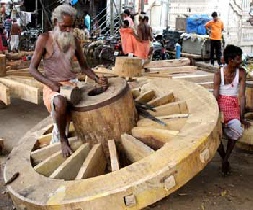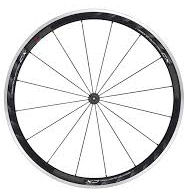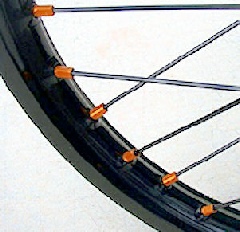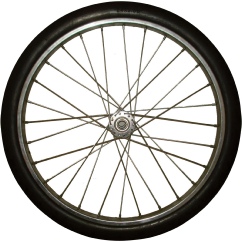









How does a spoked wheel work?


What is a wheel for? To support a load and allow it to be moved around. At its simplest, a wheel can just be a solid wooden disc. But that’s heavy. If you want to move it and its load around, a lighter wheel would be better.
You can make it lighter by chopping bits out, leaving ‘spokes’ to connect the rim to the hub. But those spokes have to be thick enough to pass the load on the hub to the rim without buckling or breaking.
The load on those early spokes was mainly compressive. The hub pressed down on the bottom spokes which in turn pressed down on the rim which was then supported by the ground. The spokes which were above the hub didn’t do much except support and locate the rim. (But bear in mind that as the wheel rotates, each spoke in turn goes dynamically from compression through bending to slight tension.)

When you move a load, you have to move the cart and the wheels as well. So it helps if they’re as light as possible, with minimum inertia. With the advent of strong metals, you could use thin wire spokes and thin metal rims. Originally those spokes were radial -
Although it looks as though the hub carrying the load is supported by all the spokes, only the top spokes carry most of the load. The hub ‘hangs’ on the top spokes as those below the hub are so thin they’d buckle under compression.
But wouldn’t it make much better use of the wheel structure if ALL the spokes helped support the load?
You can do this by tensioning the spokes. (This can be done by connecting the spoke to the rim using a screwed nipple.) Then if the tension’s sufficient, the spokes at the bottom can act in compression too as long as the compressive load is less than the tension in the spokes created by turning the nipple so that the spokes remain in net tension and act structurally as rigid columns.
So for a spoked hub with tensioned spokes, ALL the spokes work together and share the loads (but not equally at any instant of wheel rotation). The weight of the load carried is transmitted to the rim by the spokes and the bottom of the rim spreads slightly, to give a larger ‘footprint’ on the ground.
It can be shown that, contrary to intuition, the load on the lower spokes is HIGHER than that on the upper ones.

For a chariot or cart, the wheel only has to roll. The movement of the cart is achieved by a horse, say, pulling it. Radial spokes are OK for this. But what if there’s no horse and the wheel itself provides the turning force, driven by pedals or an engine?
Radial spokes are not very good at transmitting power or torque to the rim and TANGENTIAL or CROSSED-

Spoke crossing is used for DRIVEN wheels but for simplicity and convenience they’re also found on rolling wheels like the front wheel of a bicycle. For radially spoked wheels, driving the wheel would stress the spoke in shear and lead to shear fractures. For cross-
Even so, spokes occasionally fail. A bicycle rider’s weight is dynamic, due to pedalling for example, and road surface irregularities, braking loads, changes in spoke stress as the wheel revolves all contribute to FATIGUE stresses in the spoke. Most spoke failures are due to fatigue and not straight tension.
16 may 2016
The following references among others were very helpful in compiling this explanation: